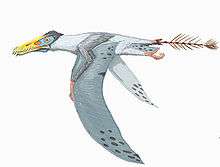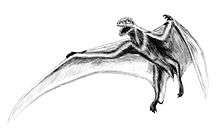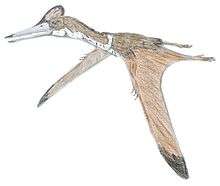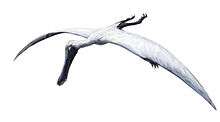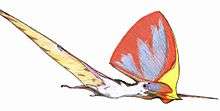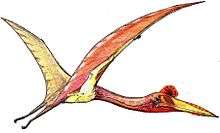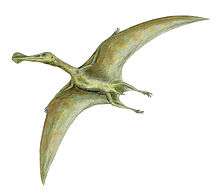Ludodactylus
Ludodactylus was a genus of pterodactyloid pterosaurs from the Early Cretaceous (Aptian) Crato Formation of the Araripe Basin in Ceará, Brazil. The genus was named by Eberhard Frey et al. in 2003 and contains one known species, Ludodactylus sibbicki. The name is derived from Latin ludus, "play" and Greek daktylos, "finger". Ludus refers to the fact, long lamented by paleontologists, that many toy pterosaurs combined teeth with a Pteranodon-like head crest, while no such creature was known to exist — however, Ludodactylus shows exactly this combination of features. "Dactylus", in reference to the characteristic long wing finger, has been a common element in the names of pterosaurs, since the first known genus was named Pterodactylus. The specific name "sibbicki" is an homage to the paleoartist John Sibbick.[1]
| Ludodactylus | |
|---|---|
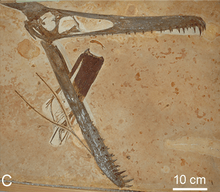 | |
| Fossil skull of Ludodactylus with yucca leaf | |
| Scientific classification | |
| Kingdom: | Animalia |
| Phylum: | Chordata |
| Order: | †Pterosauria |
| Suborder: | †Pterodactyloidea |
| Clade: | †Anhangueria |
| Genus: | †Ludodactylus Frey et al. 2003 |
| Type species | |
| †Ludodactylus sibbicki Frey et al. 2003 | |
Description

Ludodactylus is based on holotype SMNK PAL 3828, a skull missing part of the head crest, that was removed from the plate before the fossil was illegally sold. Unlike other ornithocheirids, it had no premaxillary crest on the snout, but did have a crest at the back of the skull. Frey et al. interpreted the deep mandible as a crest on the lower jaws. Trapped between the rami of the mandible is a yucca leaf; Frey suggested that the animal got it caught in its beak and unsuccessfully tried to dislodge it (the edge of the leaf is frayed), and then possibly died from starvation or a complication of starving. The skull would have been more than 66 cm (26 in) long.[1]
Classification
Frey et al. in 2003 classified Ludodactylus in the family Ornithocheiridae. In 2007 Frey, had reconsidered the validity of Ludodactylus, suggesting that it may represent the same animal as, and be a junior synonym of Brasileodactylus. However, Andres & Myers (2013), in a large cladistic analysis of pterosaurs, found Ludodactylus to be slightly more closely related to ornithocheirids and anhanguerids than to Brasileodactylus. In the analysis of Andres and Myers, Ludodactylus is classified just outside Ornithocheiridae and Anhangueridae as a derived member of the more inclusive group Pteranodontoidea.[2]
Below is a cladogram showing the results of a phylogenetic analysis presented by Andres et al., 2014.[3]
| Pteranodontoidea |
| ||||||||||||||||||||||||||||||||||||||||||||||||||||||
The cladogram below is a topology recovered by Pêgas et al. (2019). In the analyses, they recovered a different set, and contrary to the topology of Andres et al. in 2014 which placed Ludodactylus as a basal member of Anhangueria, Pêgas et al. placed this genus within the family Anhangueridae instead.[4]
| Anhangueria |
| ||||||||||||||||||||||||||||||||||||||||||||||||||||||||||||
References
- Frey, E., Martill, D., and Buchy, M. (2003). A new crested ornithocheirid from the Lower Cretaceous of northeastern Brazil and the unusual death of an unusual pterosaur. In: Buffetaut, E., and Mazin, J.-M. (eds.). Evolution and Palaeobiology of Pterosaurs. Geological Society Special Publication 217:56-63. ISBN 1-86239-143-2.
- Andres, B.; Myers, T. S. (2013). "Lone Star Pterosaurs". Earth and Environmental Science Transactions of the Royal Society of Edinburgh: 1. doi:10.1017/S1755691013000303.
- Andres, B.; Clark, J.; Xu, X. (2014). "The Earliest Pterodactyloid and the Origin of the Group". Current Biology. 24: 1011–6. doi:10.1016/j.cub.2014.03.030. PMID 24768054.
- Rodrigo V. Pêgas, Borja Holgado & Maria Eduarda C. Leal (2019) On Targaryendraco wiedenrothi gen. nov. (Pterodactyloidea, Pteranodontoidea, Lanceodontia) and recognition of a new cosmopolitan lineage of Cretaceous toothed pterodactyloids, Historical Biology, doi:10.1080/08912963.2019.1690482

